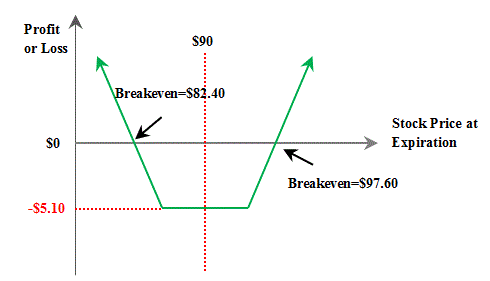Outlook:
Bearish
Bear Put Spread - Buy Higher Strike Put, Sell Lower Strike Put
Strategies...
- Sell lower strike put
- Buy same number of higher strike puts with the same expiration date.(either ATM or sightly OTM)
- Downward Trend
Example...
Hewlett-Packard Company (
NYSE:HPQ) is trading at $22.50 on May 26, 2012.
Buy the Nov 2012
$22 put option for $2.10
Sell the Nov 2012
$17 put option for $0.55.
You're bearish on this stock, so you bought
Nov 2012 $22 put.
Why Buy a Put? Buying a puts will cap your downside. If price goes down, you have the right to sell your stock at price $22.
Why Write/Sell a Put? Selling a put means you expect stock price rise or remains sideways in the next few months. You'll receive premium $0.55 by writing a put, and now your maximum risk has reduced to $1.55 per share.
 |
| Bear Put Spread |
How does Bear Put Spread work?
Stock price fall to $17.00...
- Buying Nov $22 Put Option = In-the-money $5.00,
- Selling Nov $17 Put Option = At-the-money, $0
- Net premium paid: $ 2.10 - $0.55 = $1.55
- Profit : $5.00 - $1.55 = $3.45
Stock price fall to $20.45...
- Buying Nov $22 Put Option = In-the-money, gain $1.55
- Selling Nov $17 Put Option = Put not exercise by Put Buyer, $0
- Net premium paid: $ 2.10 - $0.55 = $1.55,
- Profit : $1.55-$1.55=$0
Stock Price rise to $23.00...
- Buying Nov $22 Put Option = Out-of-the-money, $0
- Selling Nov $17 Put Option = Put not exercise by Put Buyer, $0
- Net premium paid: $ 2.10 - $0.55 = $1.55
- Profit: -$1.55
 |
| Bear Put Spread |
Disadvantage... Capped upside profit if the stock falls.
Maximum Loss: $2.10-$0.55=$1.55
(premium paid - premium received = net paid)
Maximum Profit: ($22.00 - $17.00)-$1.55=$3.45
(Different in strike - net paid)
Breakeven: $22.00-$1.55=$20.45
(Higher strike - net paid)





































